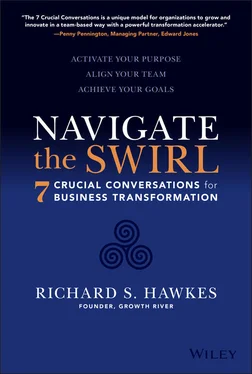In addition to these pressures, there are other elements of change creating great impacts for us. Regulatory changes are rightfully requiring us to serve our clients and their best interest. The economics of our business model are also under pressure—the transaction of purchasing securities has become a commodity and is nearly a free good. Competitive forces have lowered the breakpoint at which clients can purchase certain products. These pressures have an impact on revenue and compensation. Perhaps your business and model are undergoing the same kind of metamorphosis.
With all these factors in play, it was clear that our firm was at an inflection point. To me, it also meant that the conditions were ideal for transformation, and for putting conditions in place for our firm that would allow us to continuously improve over time. It's important in this context to recognize the difference between change and transformation. Change occurs in linear, predictable, and incremental ways—a change to a digitally enabled value proposition, for example. Transformation, on the other hand, is more vertical. It's often about multi-stakeholder (rather than single-stakeholder) impact, and it fundamentally impacts the purpose, culture, leadership, strategy, capabilities, and operating model of a company simultaneously. Transformation is riskier and more unpredictable than change.
Companies transform for one of two reasons. One, they're in a crisis; or two, because they get to—they see that the journey and the effort will be worth it, and they're excited by the possibilities. They recognize that transformational impact can improve not only the commercial enterprise, but also lives and possibilities. Edward Jones is firmly in the second camp. When you have a vision of the impact you want to have, you can either bring that vision down to fit your current reality or you can pull reality up to meet your vision as it was intended to be. Here again, we're in the latter group.
We're pulling reality up to our vision, and we're doing it from a position of strength. We began a change journey not as a discrete event with beginning and end points, but one that creates sustainable conditions for the firm to continuously improve and increase our impact over time—in fact, to quicken the pace of growth and innovation.
The Framework of Transformation
Every transformation must start somewhere—but it's not always easy to know where to start. We saw our initial challenge as identifying the future state we wanted for our firm, and the key competitive advantage that would endure through and beyond our transformation. As we began the work, we considered our purpose, culture, leadership, and capabilities, which helped us identify the gaps between where we were and where we aspired to be. We asked ourselves how we could future-proof our firm.
This exercise was, and is, a deeply human endeavor. We were considering the transformation of a beloved and impactful enterprise, one that tens of thousands of associates and millions of clients take very personally. Our mindset, our relationships, and the ways in which we collectively agreed to lead into the future, became fundamental to the work we were doing.
I believed strongly—and still do—that having a strong organizational purpose is the key to unlocking that organization's human potential. It provides a framework that everything else can be built upon. A worthy purpose unleashes the human spirit. It galvanizes people, and that's critically important, because the “how” of transforming from one thing to something else is hard. In fact, it flies right in the face of a deep human desire—to get good at something and stay good at it by relying on the things that helped you get good at it in the first place.
For a transformation to be successful, it needs to be purpose-driven, leader-led, and team-based. Those may sound like abstract or lofty words, but they become tangible and actionable when you put them to work in a large organization with a long history of working a certain way.
In our case, having some outside perspective proved to be very helpful—and confidence-boosting. We began working with Richard Hawkes and his team at Growth River to help us clarify the approach we wanted to align around in our multiyear journey. The Growth River Operating System, and in particular the Seven Crucial Conversations, are all built upon a specific way of thinking about teams and organizations, a unique model for understanding businesses, and a particular perspective on how organizations grow and innovate in a team-based way. Richard and his team helped us understand these foundational concepts, which helped set the stage for our journey.
It's also important to note that the Growth River team helped us develop a common vernacular that's proven very helpful in how we approach situations. I've likened it to the language of accounting—everyone knows what a debit or credit is, for example, and we agree on what we're talking about when we use those words. I can't stress enough how important it is to establish a common language around transformation—it makes it easier for us to have meaningful conversations and ensure that we consistently understand each other.
In our case, we've developed a dialect that's unique to Edward Jones. It's connected to our culture and rooted in terminology we've used for a long time. We have added a language associated with a common understanding of how a high-performing team works in concert.
With this language in place, we can have conversations that build more trust with one another and can deeply engage on topics that are critical to our transformation. The language and behaviors of a high-performing team are not intended to make things easy—they exist to make challenging work more productive while unleashing the spirit of the terrifically talented people you have on your team. Richard's team helped us recognize the importance and power of our language and helped us establish a baseline for it. From there, it has become uniquely ours.
An Organization-Wide Approach
Growth River also helped us unlock the full potential of teams within our organization. The theory behind it is simple: we're able to do much more as a team than we can individually. Companies are not machines. They are social systems made up of individuals who themselves have a purpose and thirst to succeed and have impact. High-performing organizations are comprised of constellations of high-performing teams.
Teams are high-performing when they bring together all the necessary perspectives—in other words, the necessary elements to form a system of roles that enable a team to be in it together—to achieve the purpose of the enterprise, the business, and every person on the team. I've learned to never underestimate the power that this concept of role definition can provide in terms of clarity and focus. Defined roles unlock the human potential within teams and then across teams, ultimately lifting the entire organization.
Our leaders and associates lean into this philosophy, advocating for a particular set of priorities that are critical for our future success. They take ownership of that perspective because they know it will ultimately create the impact on our clients, colleagues, and communities that we want to have.
It's an approach that works because we are organized around a shared purpose. That purpose is to partner for positive impact to improve the lives of our clients and colleagues, and together, better our communities and society. It's a purpose that guides everything we do. Every decision is made, and every action is done, through the lens of our purpose. It's our “why.” It reinforces the notion that our firm does not exist only to help people build wealth. We're more than that. We help people achieve things they might never have otherwise thought possible. We help them connect to their own purpose and bring it to life. Our purpose is the wellspring of our culture, leadership, business strategy, capabilities approach, and operating model. It demands that there be a logical connection among all those dimensions of our approach to growth and innovation.
Читать дальше












